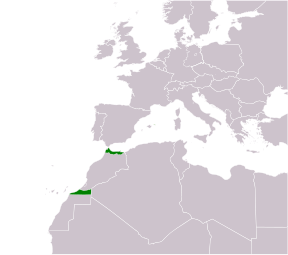
Back الحماية الإسبانية على المغرب Arabic لحماية الصبليونية على لمغريب ARY Protectoráu español de Marruecos AST Іспанскае Марока Byelorussian Испанско Мароко Bulgarian Maroko spagnol Breton Protectorat espanyol al Marroc Catalan Španělské Maroko Czech Spansk Marokko Danish Spanisch-Marokko German
This article needs additional citations for verification. (April 2017) |
Spanish protectorate in Morocco | |||||||||
|---|---|---|---|---|---|---|---|---|---|
| 1912–1956 | |||||||||
| Anthem: Marcha Real | |||||||||
 Map of the protectorate's northern zone (Spanish Morocco proper) and southern zone (Cape Juby) | |||||||||
 Map of the northern zone in 1956 | |||||||||
| Status | Protectorate | ||||||||
| Capital | Tetuán | ||||||||
| Common languages | Spanish (official) Berber Arabic Tetuani or Haketia | ||||||||
| Religion | Islam (majority) Catholicism Judaism | ||||||||
| Government | Absolute monarchy (under protectorate) | ||||||||
| Sultan | |||||||||
• 1912–1927 | Yusef | ||||||||
• 1927–1956 | Mohammed V | ||||||||
| High Commissioner | |||||||||
• 1913 (first) | Felipe Alfau Mendoza | ||||||||
• 1951–1956 (last) | Rafael García Valiño | ||||||||
| Historical era | Interwar period | ||||||||
| 27 November 1912 | |||||||||
• Rif War | June 1921 – May 1926 | ||||||||
| July 1936 | |||||||||
| June 1940 – October 1945 | |||||||||
• Retroceded to Morocco | 7 April 1956 | ||||||||
| Currency | Spanish peseta | ||||||||
| |||||||||
The Spanish protectorate in Morocco[a] was established on 27 November 1912 by a treaty between France and Spain[2] that converted the Spanish sphere of influence in Morocco into a formal protectorate.
The Spanish protectorate consisted of a northern strip on the Mediterranean and the Strait of Gibraltar, and a southern part of the protectorate[3] around Cape Juby, bordering the Spanish Sahara. The northern zone became part of independent Morocco on 7 April 1956, shortly after France relinquished its protectorate. Spain finally ceded its southern zone through the Treaty of Angra de Cintra on 1 April 1958, after the short Ifni War.[4] The city of Tangier was excluded from the Spanish protectorate and received a special internationally controlled status as Tangier International Zone.
Since France already held a protectorate over most of the country and had controlled Morocco's foreign affairs since 30 March 1912, it also held the power to delegate a zone to Spanish protection.[5] The surface area of the zone was about 20,948 km2 (8,088 sq mi), which represents 4.69% of modern-day Morocco.
- ^ Presidency of the Government (11 October 1997). "Real Decreto 1560/1997, de 10 de octubre, por el que se regula el Himno Nacional" (PDF). Boletín Oficial del Estado núm. 244 (in Spanish). Archived (PDF) from the original on 24 September 2015.
- ^ "Treaty Between France and Spain Regarding Morocco". The American Journal of International Law. 7 (2 [Supplement: Official Documents]): 81–99. 1913. doi:10.2307/2212275. JSTOR 2212275. S2CID 246007581.
- ^ Vilar 2005, p. 143.
- ^ Gangas Geisse & Santis Arenas 2011, p. 3.
- ^ Woolman 1968, pp. 14–16.
Cite error: There are <ref group=lower-alpha> tags or {{efn}} templates on this page, but the references will not show without a {{reflist|group=lower-alpha}} template or {{notelist}} template (see the help page).

